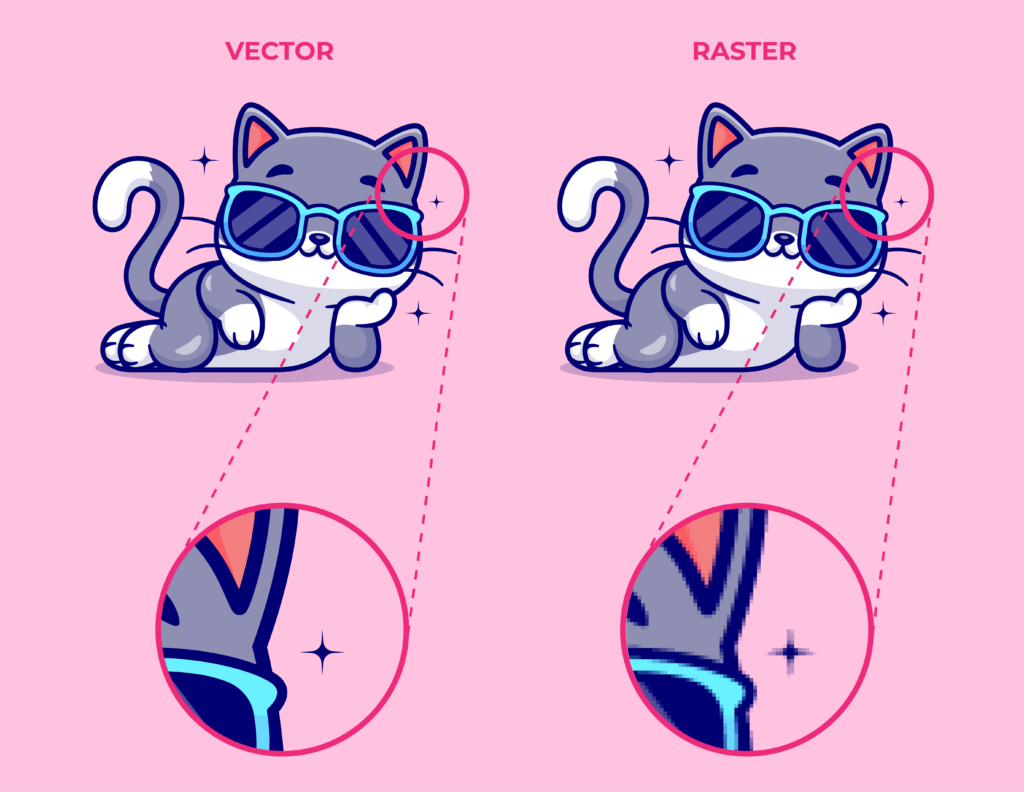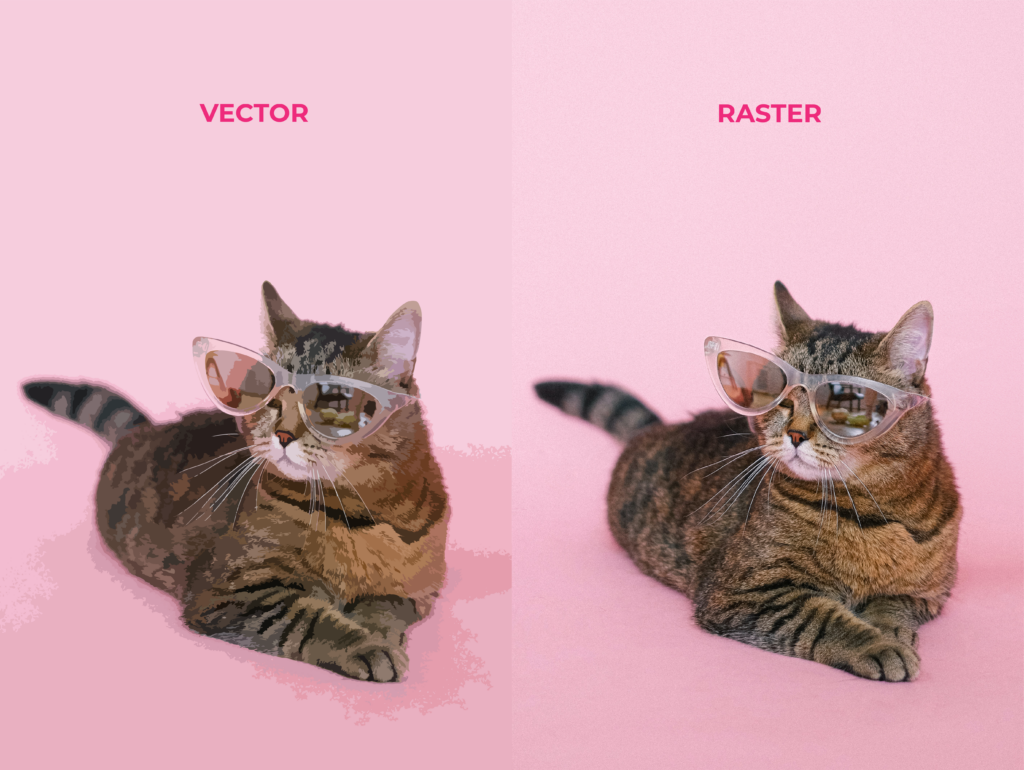If you’ve ever worked with a designer or a printer, or if you’re learning to DIY graphic design, I’m sure you’ve come across the term “vector file”. I know the concept of vector files may seem complicated at first. But stick with me and by the end of this article, you’ll be a pro at understanding what vector files are, why designers love them, and how you can use them to create versatile graphics for your business. Sound good? Alright, let’s get started!
What is a Vector File?
A vector file is a digital graphic that uses mathematical equations to describe shapes and lines. Unlike raster images that use pixels, vector files are resolution-independent. What does that mean in plain English? It means that no matter how big or small you make a vector image, it won’t lose quality or become pixelated. Cool, right?
Imagine you have a drawing of a cat that you want to print on your business card and on a huge billboard. If you’re working with a raster image (such as JPG and PNG), you would need to make sure the resolution is high and the size is right or the billboard image will be extremely pixelated.
If you were working with a vector file (EPS, SVG), you can use the same file for the business cards and the billboard. No matter how big or small, it will always look crisp and sharp because there are no pixels in a vector file.

What Can’t Be a Vector File?
While vectors are awesome, there are some limits. Vector files work best for logos, illustrations, type, and graphic elements that have solid areas of color.
Photos, on the other hand, have a lot of complex textures and colors that are not a good fit for vectors. That’s because photos contain so many tiny variations in shading and hues that can’t be accurately reproduced with vector shapes.
For photos, it’s better to use a raster format like JPG or PNG that can capture all those subtle color and tone variations. Vectors just can’t measure up for realistic photographic images.

How are Vector Files Used?
You’ll encounter vector files in many different areas of design work. Here are some of the most common ways vector files get used:
Logo Design and Branding
Vector files are the go-to choice for creating logos and establishing brand identities. Logos need to be versatile, appearing on everything from tiny business cards to massive billboards. Vector graphics keep logos sharp and clear at any size, which is super important for making a memorable and professional impression.
With vector files, designers can resize logos easily without losing quality. This flexibility is crucial when you want a consistent brand look across websites, social media, product packaging, and promotional goodies.
Print Materials
Vector files are also important in the world of print design. Whether you’re working on business cards, flyers, brochures, posters, or banners, vector graphics guarantee that your printed materials look crisp and vibrant. This is particularly important for marketing collateral and promotional items, where image quality directly impacts the perception of your business.
When you send your print designs to a professional printer, they’ll often recommend vector files to ensure that the final product meets the highest quality standards.
Web Design
In web design, vector graphics play a crucial role in creating visually appealing and responsive websites. Icons, buttons, and illustrations can all be designed as vectors, providing several advantages:
Scalability: Vector graphics can be resized without losing quality, ensuring that icons and images look sharp on devices with various screen sizes and resolutions.
Fast Loading: Smaller file sizes mean quicker website loading times, which is essential for providing a smooth user experience.
Flexibility: Designers can easily tweak colors, shapes, and sizes to adapt to evolving design trends or branding changes.
Illustrations
Artists and illustrators are big fans of vector files, and for good reason! They offer an incredible level of flexibility and precision. Whether creating digital art, character designs, infographics, or technical drawings, vector graphics allow for fine-tuned control over every line, curve, and color.
Vinyl Cutouts and Signage
Ever noticed those eye-catching vinyl graphics on storefront windows, or vehicles? Many of these are created using vector files. Vinyl cutouts and signage rely on vector graphics because they can be precisely cut and applied to surfaces, resulting in polished and professional displays.
Common Vector File Formats
Okay, so now you know what vector files are and how they’re used. But what file formats are we talking about? Here are some common ones:
- SVG (Scalable Vector Graphics): A web standard and the most common vector format. SVGs can be used on websites and supported by most design programs.
- EPS (Encapsulated PostScript): A vector format commonly used in print design.
- AI (Adobe Illustrator): The native vector format for Adobe Illustrator.
- PDF (Portable Document Format): PDFs can contain both raster and vector data. Useful for digital distribution.
What Programs Can Create and Open Vector Files?
Many design programs like Adobe Illustrator, Affinity Designer, Inkscape, CorelDraw, and even Canva can create and edit vector files.
Vector files like SVGs, EPS, and PDFs can often be opened using free web browsers, PDF readers, and basic image editing apps as well.
So you don’t necessarily need expensive software to work with vector files!
Why Do You Need to Know About Vector Files?
Now, you might be wondering why this information matters to you, especially if you’re not a designer. Well, here’s why:
Collaboration: If you work with designers or printers, understanding vector files will help you communicate your needs effectively.
Quality: When you know about vector files, you can ensure that your brand logo always looks sharp and professional.
DIY Projects: Want to create your own business cards or social media posts? Knowing about vector files can save you time and frustration.
So, there you have it! Vector files are a powerful tool in the world of design, allowing for flexibility, versatility, and high-quality graphics. Whether you’re managing a business, getting creative with DIY projects, or just curious about design, knowing about vector files can be a handy skill to have in your toolbox. I hope this simple overview helps explain what vector files are all about. Let me know if you have any other questions!

